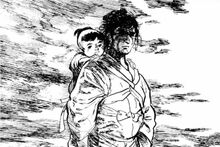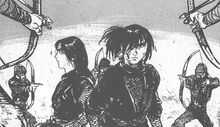| This article is a stub. You can help the Animanga Wiki by expanding it, or perhaps you could contribute to discussion on the topic. |
Gekiga (劇画) is a Japanese term for comics that literally means "dramatic pictures". It describes comics aimed at adult audiences with a cinematic style and more mature themes. The name gekiga was coined in 1957 by Yoshihiro Tatsumi and adopted by other more serious Japanese cartoonists, who did not want their trade to be known by the more common term manga or "whimsical pictures". It is akin to English speakers who prefer the term "graphic novel", as opposed to "comic book".
History[]

The Gekiga manga Lone Wolf and Cub.
In the 1950s, mainstream manga came from Tokyo and was aimed at children, led by the work of Osamu Tezuka.[1] Before Tezuka moved to Tokyo, he lived in Osaka and mentored artists such as Yoshihiro Tatsumi and Masahiko Matsumoto who admired him.[2] Although influenced by Tezuka and his cinematic style, Tatsumi and his colleagues were not interested in making comics for children. They wanted to write comics for adults that were more graphic and showed more violence.[3][4] Tatsumi explained, "Part of that was influenced by the newspaper stories I would read. I would have an emotional reaction of some kind and want to express that in my comics."[3]
Irma Nunez of The Japan Times wrote that "Rather than simply use "gekiga" as a banner to legitimize adult content and realism in manga, however, they developed a whole new aesthetic."[3] Matsumoto's son said that these artists felt that the shorter stories Tezuka started writing after moving to Tokyo, narrowed his expression as action needed to be explained in speech bubbles.[2] Nunez explained, "Structural integrity was one of the pioneers' primary concerns. They experimented with how best to blend images with the text; how a closeup might express the interiority of a character; how to synchronize a story's action with the pace of the reader's gaze as it covered the page."[3]
Rather than working for the mainstream publications, the gekiga artists worked in the rental manga industry; where the work of several artists were printed in collections, that readers borrowed from stores and then returned like video rentals.[5] In November 1956, Masahiko Matsumoto used the term komaga (駒画) to describe his work Kyūketsu-jū, instead of manga. Matsumoto's son later claimed this work was the basis for what would later be known as gekiga.[2] Yoshihiro Tatsumi's work Yūrei Taxi was the first to be called gekiga when it was published at the end of 1957.[6] Other names he considered include katsudōga and katsuga, both derived from katsudō eiga or "moving pictures", an early term for films, showing the movement's cinematic influence.[7]
In 1959, the Gekiga Kōbō (劇画工房) formed in Tokyo with eight members including Tatsumi, Matsumoto and Takao Saito.[5] The group wrote a sort of "Gekiga Manifesto" that was sent to various publishers and newspapers declaring their mission.[8][5][6] Although it was very short-lived, the group's influence was long lasting.[5][8]
The avant-garde magazine Garo, founded in 1964, was an outlet for experimental and unconventional works that were "visually or thematically too challenging for the mainstream market". With works like Sanpei Shirato's Kamui, it quickly gained a following among college students.[5][4] In response to the success of Garo, Tezuka founded the magazine COM in 1967 for more experimental works.[5]
"What I aimed to do was increase the age of the readership of comics. It wasn't that I was trying to create anything literary, but I did want to create an older audience. I didn't do that single-handedly, but I did succeed to a certain level. And, again, part of that was accomplished out of necessity. There was an incommensurable difference between what I wanted to express and what you could express in children's comics." - Yoshihiro Tatsumi, on being called the "grandfather of Japanese alternative manga."[3]
By the late 1960s and early 1970s, the children who had grown up reading manga wanted something aimed at older audiences and gekiga provided that niche. The Cartoon Museum describes the gekiga audience: "Drawn in a more realistic and atmospheric style with grittier story lines, gegika attracted older teenagers, university students and eventually adult readers."[5] That particular generation came to be known as the "manga generation" because it read manga as a form of rebellion, which was similar to the role that rock music played for hippies in the United States.
Some authors use the term gekiga to describe works that only have shock factor. In 1968, Tatsumi published Gekiga College because he felt gekiga was straying too far from its roots and wanted to reclaim its meaning.[4] In 2009, he said "Gekiga is a term people throw around now to describe any manga with violence or eroticism or any spectacle. It's become synonymous with spectacular. But I write manga about households and conversations, love affairs, mundane stuff that is not spectacular. I think that's the difference."[9]

The Gekiga manga; Kamui
The Cartoon Museum wrote that by the 1980s, gekiga became integrated into various types of manga. "For some younger people the term gekiga is now consigned to the history books, but its legacy lives on."[5]
For a long time gekiga manga was not translated in other languages, after 2000 more and more publishers dedicated to graphic novel literature began to explore the history of Japanese gekiga manga. The French publisher Cornélius published books by Tezuka, Tatsumi, Mizuki, and several others. In English first Viz and Vertical published the most known series by Tezuka. More recently publishers like Drawn and Quarterly, Fantagraphics Books began publishing several English translated editions of artists such as Shigeru Mizuki, Tatsumi, Katsumata, Tsuge, and Seiichi Hayashi, gaining more attention to the genre in the Western comic book market.
Notable artists[]
The following is a list of manga artists known to have created works from the gekiga perspective.
- Ryoichi Ikegami (Spider-Man: The Manga)[10]
- Ikki Kajiwara (Karate Jigoku-hen)[11]
- Susumu Katsumata
- Noboru Kawasaki (Star of the Giants)[12]
- Kazuo Koike (Lone Wolf and Cub)[7]
- Goseki Kojima (Lone Wolf and Cub)[7]
- Masahiko Matsumoto (Cigarette Girl)[4]
- Shigeru Mizuki (Showa: A History of Japan), Nonnonba, Onward Towards Our Noble Deaths)
- Takao Saito (Golgo 13)[1]
- Sanpei Shirato (Kamui)[5]
- Yoshihiro Tatsumi (A Drifting Life)[8]
- Osamu Tezuka (some of his adult oriented comics like MW, The Book of Human Insects, Apollo's Song, Alabaster, Barbara, Ayako, Buddha, Message to Adolf)
- Yoshiharu Tsuge (Screw Style)[13]
References[]
- ↑ 1.0 1.1 Lewis, Leo (2015-10-16). "Interview: 'Golgo 13' creator Takao Saito". Financial Times. https://www.ft.com/content/734f95c0-7260-11e5-a129-3fcc4f641d98.
- ↑ 2.0 2.1 2.2 Wells, Dominic (2014-09-23). "Meet the men behind manga: Gekiga exhibition launches at London Cartoon Museum". London, Hollywood. https://londonhollywood.wordpress.com/2014/09/23/meet-the-men-behind-manga-gekiga-exhibition-launches-at-london-cartoon-museum/.
- ↑ 3.0 3.1 3.2 3.3 3.4 Nunez, Irma (2006-09-24). "ALTERNATIVE COMICS HEROES: Tracing the genealogy of gekiga". The Japan Times. https://www.japantimes.co.jp/culture/2006/09/24/books/book-reviews/tracing-the-genealogy-of-gekiga/#.W1ysDMInbIV.
- ↑ 4.0 4.1 4.2 4.3 Santos, Carlos (2010-07-22). "Manga for Grown-Ups: Gekiga, Garo, Ax, and the Alternative Manga Revolution". Anime News Network. https://www.animenewsnetwork.com/convention/2010/manga-for-grown-ups/gekiga-garo-ax-and-the-alternative-manga-revolution.
- ↑ 5.0 5.1 5.2 5.3 5.4 5.5 5.6 5.7 5.8 "Gekiga: Alternative Manga from Japan". The Cartoon Museum. http://www.cartoonmuseum.org/exhibitions/past-exhibitions/50109-gekiga-alternative-manga-from-japan. Cite error: Invalid
<ref>tag; name "museum" defined multiple times with different content - ↑ 6.0 6.1 Suzuki, Shige (2013). "Manga's Cultural Crossroads". Routledge. p. 53.
- ↑ 7.0 7.1 7.2 Shamoon, Deborah (2011). "Mangatopia: Essays on Manga and Anime in the Modern World". Libraries Unlimited. p. 21.
- ↑ 8.0 8.1 8.2 Garner, Dwight (2009-04-14). "Manifesto of a Comic-Book Rebel". https://www.nytimes.com/2009/04/15/books/15garn.html?_r=1.
- ↑ Ho, Oliver (2009-08-01). "From Gekiga to Good Raymond". PopMatters. https://www.popmatters.com/109053-from-gekiga-to-good-raymond-connecting-japans--2496063480.html.
- ↑ Thompson, Jason (2010-08-19). "Jason Thompson's House of 1000 Manga - Spider-man: The Manga". Anime News Network. https://www.animenewsnetwork.com/house-of-1000-manga/2010-08-19.
- ↑ "From Kajiwara Ikki Part 1: The Dangerous Charm of a Dark World". ComiPress. 2008-02-06. https://www.comipress.com/special/manga-zombie/incredibly-strange-manga-part-4/kajiwara-ikki-1.html.
- ↑ Clements, Jonathan (2013). "Anime: A History". Bloomsbury Publishing. p. 143. https://books.google.com/books?id=dyBdDwAAQBAJ&pg=PAPT143.
- ↑ Ressler, Karen (2018-07-20). "Drawn & Quarterly to Publish Collected Works of Yoshiharu Tsuge". Anime News Network. https://www.animenewsnetwork.com/news/2018-07-20/drawn-and-quarterly-to-publish-collected-works-of-yoshiharu-tsuge/.134520.
